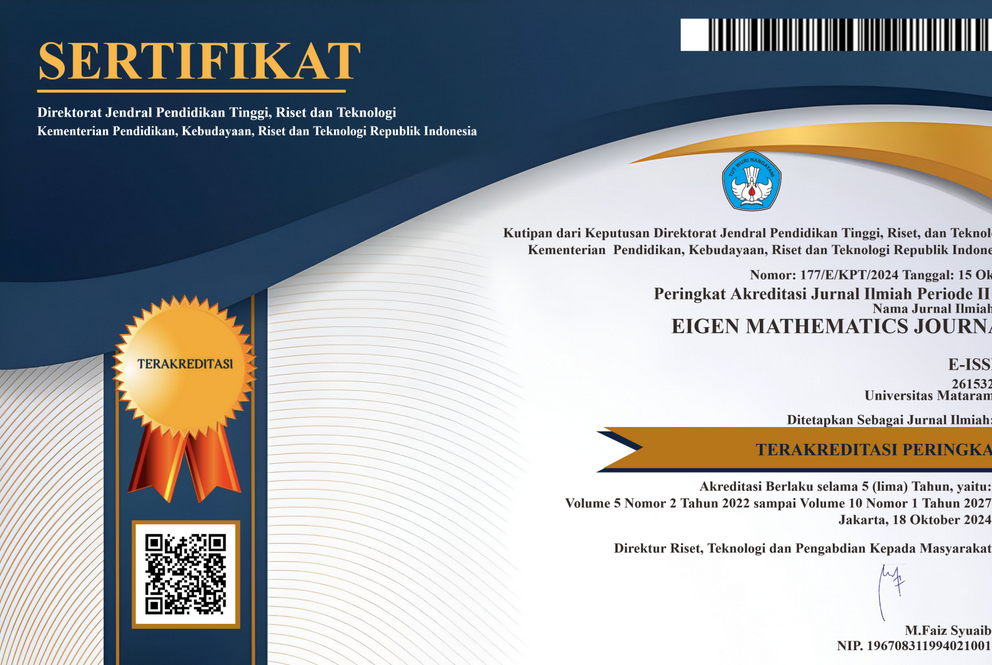Comparison of Fuzzy Time Series Methods and Autoregressive Integrated Moving Average (ARIMA) for Inflation Data
DOI:
https://doi.org/10.29303/emj.v4i2.122Keywords:
Autoregressive Integrated Moving Average (ARIMA), Fuzzy Time Series, Inflation, MAPE, MSEAbstract
This study compares the Fuzzy Time Series (FTS) method with the Autoregressive Integrated Moving Average (ARIMA) method on time series data. These two methods are often used in predicting future data. Forecasting or time-series data analysis is used to analyze data in the form of time series. In this study, Indonesian inflation data was used to be analyzed in comparing the FTS and ARIMA methods. Inflation is one of the economic indicators used to measure the success of a country's economy. If the inflation rate is low and stable, it will stimulate economic growth. This inflation value is calculated every month where the value can decrease and increase from one period to another. Comparison of the FTS and ARIMA methods is seen in the error value generated by the two methods. A method can be better than other methods if the value of the resulting forecast error is smaller. In this study, Mean Squared Error (MSE) and Mean Absolute Percentage Error (MAPE) were used to see the magnitude of the error value of the two methods on the fives data testing used. The results obtained in this study are the results of Indonesia's inflation forecast for the period January to May 2021 using the FTS method, respectively, at 0.57%, 0.375%, 0.2%, 0.2%, and 0.1125%, while the forecast results using the ARIMA method, respectively. Of 0.3715848%, 0.2362817%, 0.1508295%, 0.1731906%, and 0.2432851% and the results of calculating the size of error using MSE and MAPE indicate that the ARIMA method with the model ARIMA(3,0,0) is better at predicting inflation data in Indonesia with a value of MSE of 0.009 and MAPE of 64.987% compared to the FTS method resulted in MSE values of 0.047 and MAPE of 132.548%.References
Amanu, Alief Muhammad. (2021). Penerapan Model ARIMA dan Fuzzy Time Series Berbasis Rerata dalam Peramalan Harga Saham (Studi Kasus: Harga Penutupan Saham PT. United Tractors Tbk). Skripsi. Bogor: Fakultas Matematika dan Ilmu Pengetahuan Alam Institut Pertanian Bogor.
Arnita, dkk. 2020. A Comparison of The Fuzzy Time Series Methods of Chen, Cheng and Markov Chain in Predicting Rainfall in Medan. Jurnal of Physics, 2(10).
Aswi dan Sukarna. 2017. Analisis Time series Teori dan Aplikasi. Makassar: Andira Publisher.
Badan Pusat Statistik (BPS) Indonesia. (2021). Inflasi. Online diambil dari: https://sirusa.bps.go.id/sirusa/indeks.php/indikator/570.
Berutu, Sunneng Sandino. (2013). Peramalan Penjualan Dengan Metode Fuzzy Time Series Ruey Chyn Tsaur. Thesis. Semarang: Program Pascasarjana Universitas Diponegoro.
Chung, Roy CP, dkk. (2009). An ARIMA-Intervention Analysis Model for the Financial Crisis in China’s Manufacturing Industry. International Journal of Engineering Bussiness Management, 1(1): 16.
Din, Marilena Aura. 2015. ARIMA by Box Jenkins Methodology for Estimation and Forecasting Models in Higher Education. Atiner Conference Paper Series, EMS2015-1846: 5.
Elena, Maria, dkk. (2012). Fuzzy Time Series and SARIMA Model for Forecasting Tourist Arrivals to Bali. Jurnal Teknologi, 57 (Sciences & Engineering) Suppl 1:79.
Fadilla dan Aravik, Havis. (2018). Pandangan Islam dan Pengaruh Kurs, BI Rate Terhadap Inflasi. Jurnal Ecoment Global. 3(2):186.
Indrasetianingsih, Artanti, dkk. (2017). Analisis ARIMA Box Jenkins Untuk Peramalan Jumlah Kunjungan Wisatawan Mancanegara di Indonesia. Seminar Nasional Matematika dan Aplikasinya, 227.
Khaironi, Luthfi Multazam. (2019). Pengaruh Pengangguran dan Inflasi Terhadap Pertumbuhan Ekonomu Provinsi Aceh. Skripsi. Banda Aceh: Fakultas Ekonomi dan Bisnis Islam Universitas Islam Negeri Ar-Raniry.
Lestari, Nofinda dan Wahyuningsih, Nuri. (2012). Peramalan Kunjungan Wisata dengan Pendekatan Model SARIMA (Studi Kasus: Kusuma Agrowisata). Jurnal Sains dan Seni ITS, 1(1): 30.
Munawwaroh, Sitti. (2010). Analisis Model ARIMA Box-Jenkins Pada Data Fluktuasi Harga Emas. Skripsi. Malang: Fakultas Sains dan Teknologi UIN Maulana Malik Ibrahim Malang.
Purnomo, Feby Satya. (2015). Penggunaan Metode ARIMA (Autoregressive Integrated Moving Average) untuk Prakiraan Beban Konsumsi Listrik Jangka Pendek (Short Term Forecasting). Skripsi. Semarang: Fakultas Teknik Universitas Negeri Semarang, 25-28.
Steven. (2013). Perbandingan Metode Fuzzy Time Series dan Holt Double Exponential Smoothing Pada Peramalan Jumlah Mahasiswa Baru Institut Pertanian Bogor. Skripsi. Bogor: Fakultas Matematika dan Ilmu Pengetahuan Alam Institut Pertanian Bogor.
Sukraini, Tri Tanami. (2016). Peramalan Kunjungan Wisatawan ke Uluwatu dengan Menggunakan Model Autoregressive Integrated Moving Average. Jurnal Matrix, 6(1): 48-49.
Sumarjaya, I Wayan. (2016). Modul Analisis Deret Waktu. Bukit Jimbaran, 36-41.
Tauryawati, Mey Lista dan Irawan, M. Isa. (2014). Perbandingan Metode Fuzzy Time Series Cheng dan Metode Box-Jenkins untuk Memprediksi IHSG. Jurnal Sains Dan Seni Pomits, 3(2): 35.
Xihao, Sun dan Yimin, Li. (2008). Average-based fuzzy time series models for forecasting Shanghai compound index. World Journal of Modelling and Simulation, 4(2): 105.
Downloads
Published
How to Cite
Issue
Section
License
All articles published in the Eigen Mathematics Journal will be available for free reading and downloading. The license applied to this journal is Creative Commons Attribution-Non-Commercial-Share Alike (CC BY-NC-SA).
Most read articles by the same author(s)
- Khalilah Nurfadilah, Adnan Sauddin, Winda Saputri, Rice Production Forecasting using Exponential Smoothing Method , EIGEN MATHEMATICS JOURNAL: Vol. 5 No. 1 Juni 2022
- Risnawati Ibnas, Satriani Satriani, Khalilah Nurfadilah, Negative Binomial and Generalized Poisson Regression Model for Death Due to Dengue Hemorrhagic Fever Data , EIGEN MATHEMATICS JOURNAL: Vol. 6 No. 1 Juni 2023






